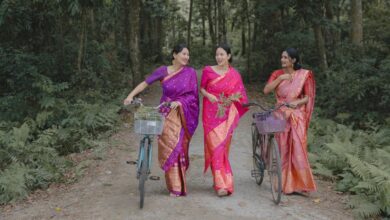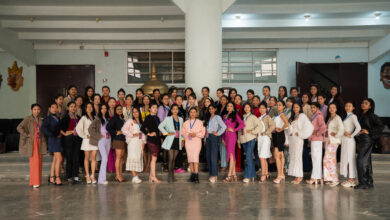Chief Minister Conrad K Sangma Attends the National Symposium ‘Threads of Heritage’ in Ri Bhoi, Meghalaya
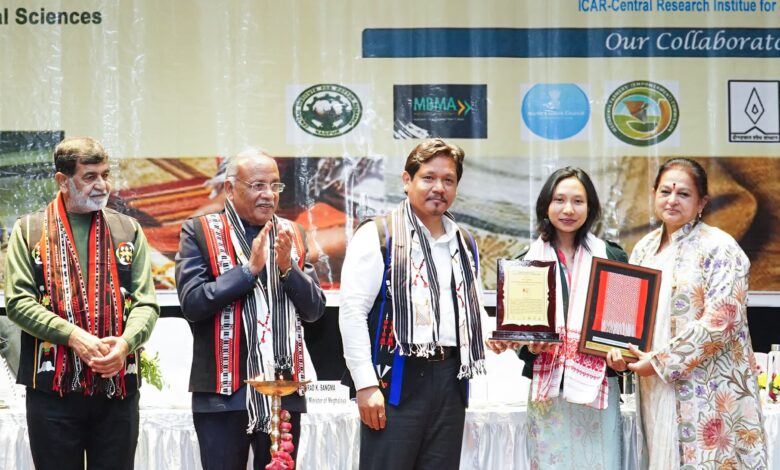
Ri Bhoi, Meghalaya – Chief Minister Conrad K Sangma was the key speaker at the National Symposium ‘Threads of Heritage: Exploring Traditional Textiles and Natural Fibres,’ held at the College of Community Science, CAU (I), Ri Bhoi, Meghalaya.

The event witnessed an inspiring gathering of dignitaries, including MLA Smt. Archana Chitnis who is representing Burhanpur (Vidhan Sabha constituency) and has served as Minister of Education of the state.[Shri Atul Jain, Vice Chancellor Dr. Anupam Mishra, along with artisans, weavers, researchers, and investors from across the country.
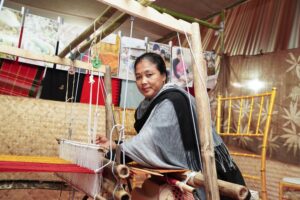
In his address, Chief Minister Sangma delivered a powerful message on the deeper significance of weaving, extending it beyond textiles to culture, history, and identity. He described weaving as a living expression of heritage, deeply embedded in Meghalaya’s traditions.
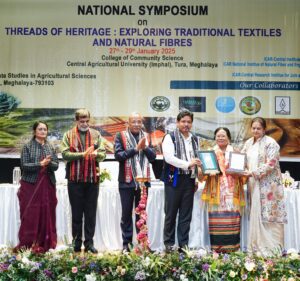
“When you weave, you are not just creating fabric; you are weaving history, culture, and identity into every thread,” he said, emphasizing the need to preserve and promote indigenous weaving traditions in a rapidly modernizing world.
He further drew a striking parallel between the art of weaving and the ancient tradition of building living root bridges in Meghalaya, where generations of Khasi and Jaintia tribes have patiently woven the roots of rubber trees over decades to create sturdy bridges. Reflecting on a recent visit to one such bridge in a village called Siej, he shared, “I met a man who has been weaving a root bridge for 60 years—he started as a boy, and now it stands strong, a symbol of resilience and tradition. Like that bridge, our textiles are not just products; they are a living legacy, woven with patience, skill, and generational wisdom.” He urged artisans to take pride in their craft and recognize that their work is more than a livelihood—it is an act of cultural preservation.
The Chief Minister also announced a major initiative to develop a dedicated bamboo and natural fibre industrial cluster in Meghalaya, which will provide artisans and entrepreneurs with infrastructure, funding, and market linkages. “Meghalaya is blessed with abundant bamboo, banana fibre, eri silk, and other natural resources. We must harness these in a way that benefits both the environment and the livelihoods of our people,” he said. He reiterated that bamboo, in particular, holds immense potential and that the government is committed to making Meghalaya a leading hub for sustainable natural fibres.
Recognizing the economic potential of traditional weaving, Sangma highlighted Meghalaya’s efforts to boost entrepreneurship through programs like PRIME Meghalaya, which has been recognized nationally for fostering startups and small businesses. Thousands of artisans and textile entrepreneurs have benefited from these initiatives, receiving crucial support in financing, marketing, and technological upgrades. “Our artisans and weavers have extraordinary talent, but they need the right tools to compete in today’s global market. That’s where the government is stepping in,” he reassured.
He also spoke passionately about the power of storytelling in marketing traditional textiles, explaining that modern consumers want to connect with the story behind the fabric. “People don’t just buy textiles; they buy the history, the craftsmanship, the human touch behind it. We need to find ways to share these stories—through branding, social media, and even tourism,” he urged.
The symposium also celebrated the achievements of artisans like Padmashri Hemoprova Chutia from Assam, recognized for her innovative weaving of sacred texts like the Bhagavad Gita using Muga silk; Mrs. Oman Siram Taki from Arunachal Pradesh, who turned her skill in loin loom weaving into a cottage industry that uplifts local women; and Meghalaya’s own Smt. Anita Koch and Smt. Efredena R. Marak, who have played key roles in preserving traditional Koch and Garo weaving while creating employment for rural women. Others, such as Sri Rejinald Khiangte, were acknowledged for providing sustainable alternatives to mining-dependent livelihoods through cooperative initiatives.
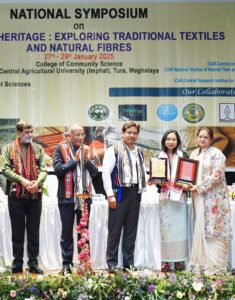

The symposium, held in collaboration with ICAR-NINFET Kolkata, ICAR-CICR Nagpur, and Deendayal Research Institute, brought together experts, policymakers, and industry leaders to discuss the future of traditional textiles in a global sustainable fashion market.
Vice Chancellor Dr. Anupam Mishra stressed the importance of documenting and researching indigenous weaving techniques to preserve this invaluable knowledge. “We must integrate technology and storytelling to create global demand for our rich handloom heritage,” he stated.
Guest of Honour Smt. Archana Chitnis highlighted the economic potential of traditional textiles, saying, “If we connect tradition with technology and a market-smart approach, India’s handloom sector has a bright future.”
Closing the event, Chief Minister Sangma reaffirmed Meghalaya’s commitment to reviving and sustaining its traditional textile industry. He called on entrepreneurs, weavers, and investors to collaborate and make the most of the state’s strengths in natural fibres. “This symposium has not just brought people together; it has woven a shared vision for the future of traditional textiles in India,” he concluded.
The event marked an important step forward in Meghalaya’s mission to protect, innovate, and globally showcase its indigenous textile heritage, ensuring that these centuries-old skills continue to thrive in the modern world.



